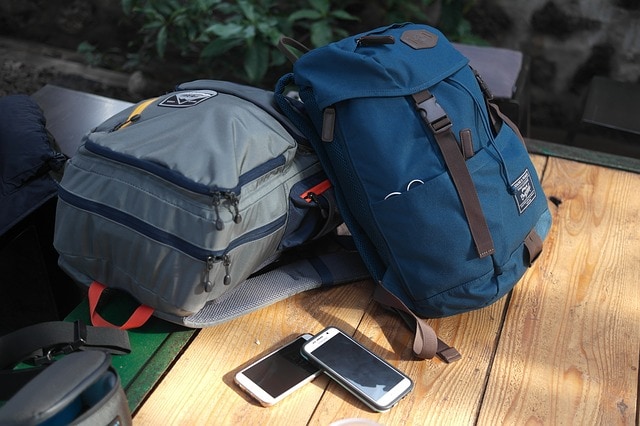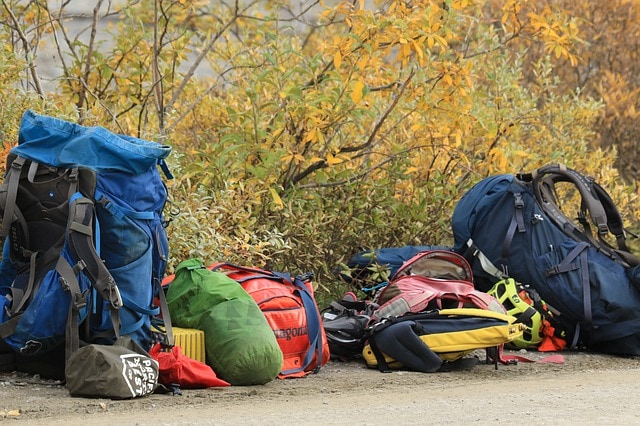What should you bring on the hike? That’s the toughest question every new and veteran hiker has to ask himself before every hike, and simply, there’s no universal answer. Someone hiking in the desert will have a drastically different hiking gear checklist compared to someone hiking in a snowy mountain, a jungle or an arctic region. There are some common points, namely the big four items and the ten essentials are something that all hikers have to bring on their hikes.
We’ll list everything you need to bring on a longer hike, and you can use the handy checklist on the bottom to make sure you covered your bases. We’ll also add a big, comprehensive “optional gear list” of gear you might want to try out on the trail.

The Big Four Items
The big four are the most important items that will make or break your hike. Your boots, tent, sleeping bag and backpack are your most important pieces of gear and you shouldn’t skimp on buying quality gear here. If any of your big four items get too damaged on the trail, you’re going to have to cut your trip short immediately.
If you lose one of your big four items or it gets damaged, you should return to town as soon as possible and buy a replacement instead of trying to “brave through” the hike. Torn and soggy boots, a damaged tent or sleeping bag that don’t keep you safe or a backpack with a torn strap is quite detrimental to your health and your hiking speed. It’s not fun, we know. It also ruins your planning and ruins your through-hike time, but it’s crucial that you stay safe and healthy.

What are the Ten Essentials?
We’ll list our version of The Ten Essentials according to Mountaineering: The Freedom of the Hills, a book written back in 1930s. The Ten Essentials are the 10 items (or groups of items) that might save your life in the case of an accident.
- Navigation
- Light
- Sun Protection
- First aid
- Knife or multitool and repair kit
- Means of starting a fire, or a stove
- Emergency Shelter
- Extra food
- Extra water
- Extra clothes
Most hikers will never have an accident in the wild, but that doesn’t mean that you should ignore these ten essential items. When packing the ten essentials, it’s not a bad idea to be a pessimist. For example, instead of just packing a map and saying you’re done, pack a backup GPS or download the topographical maps on your phone too and a PLB.
1. Navigation

You shouldn’t go on a hike without some way of navigating and orienting yourself in nature unless you’re going on a well-marked popular trail. Most of the stuff people learn in school don’t work in the wild. Moss grows in dark and moist places, not just on the north part of the tree, and following a river might not help you reach a town or village.
In the past, maps and compass were the most popular orienting tools, and these days we have very precise standalone GPS and smartphone GPS. It’s still recommended that you bring a regular map alongside your high tech gadgets.
Accidents like getting your electronics wet happen on the trail, but it’s more likely you’ll naturally drain the battery over time. Carry an extra powerbank and keep it in a dry sack, it’s much more energy efficient and just as light as a solar panel. A PLB (Personal Locator Beacon) is always a good idea; it’s a satellite beacon that will call first responders to your current locations in the case of an emergency.
2. Light

Don’t be caught outside in the dark without a flashlight or a headlight. Even if you’re on a day hike, there’s a small chance that it will take more time than you planned, and you’ll be home at 11 PM instead of 5 PM.
What we recommend is a headlamp with a red light that doesn’t strain your eyes as much (and the eyes of your fellow hikers). It doesn’t have to be the brightest light (although that helps), but it’s important that the lamp is durable and reliable.
Always pack an extra battery charge, and if you can, use rechargeable batteries that you can top off in between hikes; you’ll leave the house with a guaranteed full charge and save the environment in the long run (as rechargeable batteries pollute less than one-use batteries).
3. Sun Protection
There are three ways you can protect yourself from the sun: using quality UV clothing, using high UV rated sunglasses and using high UV sunscreen. Basketball caps and hats can save you from sun-poisoning, scalp skin burns, headaches and nausea. A small tube of sunscreen is light and easy to pack, compared to a bottle of sunscreen.
People usually downplay or don’t know how harsh the sun is on many hikes, especially on trails at higher elevations. Not taking care of your skin and not protecting yourself from the Sun could bring you a lot of trouble on the trail, from headaches to vomiting, dehydration, fevers, infections and a lot of pain.
4. First Aid
A good First Aid Kit is inexpensive and light, and could be the most valuable thing you carry in your pack if the situation calls for it. Your kit should be full of gear you know and can use (please take a First Aid class if possible), or in a pinch, you could provide the gear that someone might use to save someone’s life.
Your first aid kit should be personalized to you, if possible. Add ibuprofen, iodine tablets, electrolytes, insulin or any other medicine you’re supposed to take while hiking that a regular off the shelf kit lacks.
5. Knife, Multitool, Repair Kit

Most hikers don’t bring knives or multitools on their hikes, and you won’t need them on most hikes. You don’t have to bring a heavy hunting knife along, but you should pack a small Victorinox Swiss army knife at least, on the off chance you might actually need it.
Sometimes gear fails and needs to be cut loose, sometimes it’s an emergency where you have to cut clothes to be able to administer first aid, or do something else that requires a bladed edge. The repair kit and tape is a life-saver on longer trips as you can sew holes in pants, buttons that fall off, tents, sleeping bags and other mishaps.
6. Fire
Maybe you’re a hiker that doesn’t use fire at all, or hiking on a trail that has a strict “no fire” rule. Regardless, you should still pack a small disposable lighter or stormproof matches. They’re both light and reliable ways to start a fire. In an emergency, you might have to spend some time in the cold, and making a fire might save your life.
Flint and tinder are a good option as well but they’re harder to use than matches or a lighter. In the rare chance that your hands might be injured, you or a fellow hiker will light a fire using the lighter/matches much faster and easier than using steel and flint.
7. Extra Clothes
Extra clothes, such as a rain coat or a warmer jacket, can help keep you warm no matter the season. A hat and gloves can help you out on a surprisingly chilly autumn night, and an extra pair of socks will save you from having wet feet and boots. An extra pair of quality wool socks that you stash somewhere in the pack can come in handy if you get your feet wet on the trail.
8. Shelter
Emergency shelter is something that most hikers either forget or decide not to pack to save up on weight. A small emergency bivy is the most efficient small shelter that you might pack. It’s generally uncomfortable but it might save your life and you shouldn’t skip packing it.
9. Extra Food and Nutrition
A hiker on the trail spends about 2000 calories more than regular; that the same energy you get from eating 4 burgers. You’re going to need the extra calories on the trail, and you should pack an extra lunch (at least), or carry an extra day’s-worth of food in the case of an emergency. Extra energy bars are a fantastic idea and can help you meet your recommended daily caloric intake.
10. Extra Water

Hikers, on average, drink about a liter of water per every two hours. If you’re someone that’s big and tall or naturally thirsty, you’ll require more water. It’s a good idea to pack an extra water bottle, knowing where the watering holes are, and having reliable water purification methods like iodine tablets, boiling the water, straw-filters, bottle filters or gravity filter systems.
In the very worst case, you can drink raw water you find in nature, as the water poisoning will kill you more slowly than dehydration. Hopefully you’ll never find yourself in this situation.
11. A Dry Sack

The unofficial 11th essential is a quality dry sack or organizer that you can pack the other ten essentials in. This is a quick and foolproof way to pack all your essential gear. Most of the time, you won’t need to remove your essential dry sack from your pack, but be sure to check the batteries every month.
Extra Gear Checklist
Bear Spray
If you’re hiking in bear country, you’re going to want to bring bear spray. It’s safe, efficient and easy to use, and it might save your life. Most national parks have places where you can rent out cans of bear spray for a very low price.

Bear Container
If you’re hiking in bear country, the last thing you want is to have a bear stealing your food and possibly attacking you. Bears have a very powerful sense of smell and you should use an airtight, bear-proof canister to keep your food in.
Bears aren’t the only thing that want to take your food, and this canister will keep mice, raccoons and other rodents away much better than a sack would.
Extra tent stakes

Most tents don’t come with enough stakes, so it’s a good idea to bring some extra tent stakes. A tent stake can have more purposes than just staking something, it can be used as a trowel.
Tent footprint
A tent’s footprint protects the tent’s floor from jagged rocks or other debris and drastically improves your tent’s lifespan. It’s lightweight enough to not bother anyone but the most ultralight backpackers.
Trekking Poles
If you’ve never used trekking poles, you should try them. Not only are they a versatile tool you can use to raise your tent, they’ll improve your speed on the trail if you’re someone who likes to walk faster than most people, and will give you more stability on wet and slippery hike trails.
Cooking Set, Utensils and Stove
If you like warm meals on the trail, don’t forget your camp cooking set, your backpacking stove and the cooking utensils. Good camping sets easily pack up in themselves and weigh little, but most campers “shave off the extra weight” and bring only one pot or only one cup.
Hand Sanitizer and Soap
Hygiene is always important, try to keep your hands as clean as you can by using a fully natural environmentally friendly soap. There are a lot of germs and bacteria on the trail, and being careless can get you sick.
Gaiters

Gaiters keep rocks, sand and other debris out of your shoes. They also keep ticks and other insects out. Gaiters are “the best kept secret of the hiking world” as most people that try them, keep using them on all their hikes.
Bug Spray
A bottle of bug spray or insect repellent will keep you safe from the various bloodsuckers you can find on a hike. Mosquitoes and ticks are not only annoying, but carry life-threatening diseases.
A Chair or a Seating Pad
There aren’t many surfaces where you can readily sit in nature, so bringing your own camping chair or a seating pad is a great idea. Old logs and rocks house a lot of bugs and the occasional snake or some other creature, and it’s sometimes risky to use them to sit down. Give them a good knock or two with a branch to scare off any critters before you sit down.
Trowel and Toilet Paper

You’ll most likely need to do your “business” in the forest. Follow the “Leave No Trace” principles and use fully biodegradable toilet paper and a small trowel.
Pillow
The humble air pillow is an optional piece of gear that most hikers leave behind. If you’re someone that loves using pillows (or haven’t used one on a trail), try it out. Sleeping in the wild will feel a lot more like sleeping at home, and might help you sleep better.


